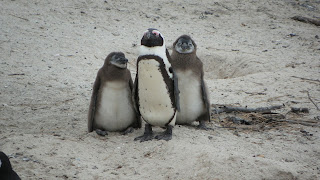 |
| Uel Maree |
It had started
off as any other regular day at a youth outreach camp beside the Berg River, a
river which Uel Maree who was 27 at the time had dived into many times before
during that summer of 2011.
Uel dived head
first with hands out in front of him into the flowing river, hitting his head
in the process. He was instantly paralysed and was floating face down in the
water for 45 seconds until another leader came to his rescue. He describes an experience
of a feeling of peace wash over him. Once he was taken out of the water and
laid across the ground, the only physical sensation he felt was that of the
African sun hitting his face. He was then airlifted to Milnerton hospital for
treatment, where he spent up to 100 days adjusting to his new condition.
Classified as an
incomplete C5 tetraplegic, Uel is cared for by his parents in their home set in
the picturesque village of Hout Bay.
Originally from Durban, now 31 years old, Uel was an avid outdoorsman who loved
days at the beach and exploring the surrounding mountains after moving to Cape
Town four years before his accident. Naturally one of his biggest concerns was
losing his sense of freedom and energetic lifestyle due to the unfortunate
accident.
Happy go lucky
by nature, once Uel was given the life-changing news that he was paralysed from
his shoulders down, he refused to accept the news as his fate, instead focusing
his energy on staying positive and working hard to regain any movement possible.
He is now able to move his arms though not his hands and fingers quite yet.
 |
| Uel in hospital shortly after the accident. |
His family,
consisting of three sisters and his parents, were left devastated yet remained
hopeful that Uel would make a complete recovery someday. The accident served as
a test to true friendship, with his friendships remaining intact and unchanged.
As a devoted Christian he describes his relationship with God as having grown
stronger since the accident and that his faith has never faltered.
Uel expressed
that the hardest part about leaving the hospital and coming back home was the
realisation that no medical professionals would be around in case of an
emergency. He described that it felt peculiar to be back in his parents’ home
after having lived without them for seven years.
Over time he has
come to understand the new condition of his body, knowing what specific sensations
and headaches indicate. He has since become used to spending lengthy periods of
time at home, watching movies, series and documentaries with the occasional get
together with friends. His dad adapted a microphone stand to have a tablet
attached to for which he uses a specially designed finger glove to type
messages and claims he is just as fast as anyone else.
 |
| Smiley Uel, with his wheelchair. |
When asked what
he felt was important for people to understand about those with disabilities,
he stated that, ‘’disability is not contagious.’’ He strongly believes that
able-bodied people should be educated on how to interact with those with
disabilities and that children should be taught from a young age about how to
deal with people affected by disabilities.
Uel, an ex KTV
presenter, has given numerous talks to teenagers and church goers, and attended
fundraisers to talk about his personal struggle with disability in the hope of
instilling knowledge and awareness. He aims to raise awareness about disability
in rural areas and wants to get medical aid regulations with regards to
disability changed as well as the import duty on wheelchairs lessened.
He jokingly
replied, ‘’don’t dive into muddy water,’’ when asked what advice he would give
to other people about the situation. Uel urges others that find themselves
suddenly paralysed to, ‘’take it slow and realise that they might be in it for
the long haul, don’t focus on the can’t rather focus on what can be done.’’
Ambitious and
keen to get involved within the disability sector, Uel recently got involved
with Accomable, a site dedicated to
listing accessible properties, for which he scouts out accessible accommodation
around the globe. A gofundme
page has been set up in Uels’ name with the goal of raising funds for an
accessible vehicle. Being 6.2 ft, it is a struggle and potential risk to load
Uel into a standard car.
‘’But whatever
may come,’’ Uel is adamant he is ready for it. And as he so wisely says;
‘’Through my accident I have realised that today is all we’ve really got. We
aren’t promised tomorrow so let’s make today count.’’
We can all learn
a thing or two through the adversities, daily struggles and determination to
live life to the fullest from those dealing with disabilities.
















